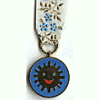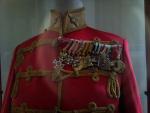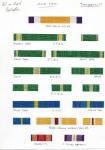-
Posts
684 -
Joined
-
Last visited
-
Days Won
3
Content Type
Profiles
Forums
Blogs
Gallery
Events
Store
Everything posted by Lukasz Gaszewski
-
Although the Russian Army never officially introduced ribbon bars, some unofficial bars used to be worn. I normally do not collect Russian items, but this one came to me along with the some Polish ribbons. All used to belong to a Polish officer who had previously served in the Russian Army. Wearing imperial Russian medals was officially prohibited in the Polish Armed Forces, but some (mostly retired) soldiers sometimes wore it unofficially, along with other medals.
-

Soviet THE SOVIET QUIZ - 2011 - QUIZ CLOSED
Lukasz Gaszewski replied to JimZ's topic in USSR: Soviet: Other Militaria
I am really happy to be the winner!!! :jumping: And if it is my turn to ask a question... Err, I thought for some time and let it be this. Please read what my hero said and try to guess who he was: -

Soviet THE SOVIET QUIZ - 2011 - QUIZ CLOSED
Lukasz Gaszewski replied to JimZ's topic in USSR: Soviet: Other Militaria
Are you by chance a diamond named Orlov, dwelling in the Diamond Fund in the Kremlin? -
Five relatively new (established 2007) Polish commemorative stars, conferred for participation in missions in designated areas. L. to r.: Afghanistan Star (2007), Iraq Star (2007), Chad Star (2010), Congo Star (2010), Mediterranean Star (2010). Each star has a ribbon in a distinctive colour with edges in the colours of the country of the mission. In the centre there is always a red stripe, flanked by narrower stripes of white. Ribbons for further possible missions will follow this pattern. A sixth star for missions in former Yugoslava had also been planned but the idea was eventually turned down. Certainly a big loss to all who had served there.
-
On the uniform there was an impressive set of medals that belonged to the prince. Please note two Crosses of Military Merit (one with swords and Kriegsdekoration, the other without them). Please enjoy identifying the medals on your own. One medal I cannot identify is the one between the Hindenburg Cross and the Hungarian War Medal for WWI. Can somebody help? Another interesting thing about the Castle at Nachod is a collection of orders and decorations, said to be an impressive one. Unfortunately, the collection is open to public only in the first weekend of every month, and I was not able to see it, and the castle is closed from November to April. So if you are planning to visit the castle, remember to do it during the first weekend of the month, from May to October.
-
In October I had an opportunity to visit the castle at Nachod in the north of the Czech Republic. The castle belonged to the princely family of Schaumburg-Lippe until 1945. Among many exhibits there were some uniforms worn by members of the Shaumburg-Lippe family. One of them, of a Major-General of Hussars, that used to be worn by prince Friedrich zu Schaumburg-Lippe, seemed particularly interesting. I hesitated whether to put this topic here or in the German section - I decided to put it here, as prince Friedrich was an officer in the k.u.k. cavalry. Friedrich Prinz zu zu Schaumburg-Lippe (1868-1945) Upon graduation of the Maria-Therezia Military Academy in Wiener Neustadt in 1888 he commenced military service, first in the 5th Hussar Regiment of Marshal Radetzky and then in the 9th Hussar Regiment in Sopron, Hungary. His military career, according to what was written next to the uniform was as follows: 1896 - Captain (Rittmeister) 1906 - Major 1910 - Lieutenant Colonel 1913 - Colonel 1916 - Major General
-
JDM has asked me to publish on his behalf the following entry to this topic, regarding the orders of the state of Terengganu - one of the least known of all Malaysian states. Doing this I would like to thank John for the information he has kindly shared with us on this forum. I can add from myself that the left ribbon in the last row belongs to the Bintang Jasa Bomba (Meritorious Service Star) of the Fire and Rescue (Bomba dan Penyelamat) Malaysia.
-

Italy- Unusual Cross for military valour
Lukasz Gaszewski replied to tjnier's topic in Southern European & Balkan States
I agree too that the 'X' denotes the de-utilization of the royal cypher and the cross may come from the transitional period (1946-47). The plain blue ribbon is kind of proof too, although not very strong (it is not difficult to substitute one ribbon for another). BTW, does anybody has information if the "merito di guerra" type cross was ever awarded with a sword on the ribbon? I have a cross inscribed "merito di guerra", however the ribbon (blue with white stripes) has a bronze Roman gladio, which as far as I know was used with the "al valore militare" type only. I suppose that the gladio could be pinned in later, just to add more splendour to the more common cross. -

Italy- Unusual Cross for military valour
Lukasz Gaszewski replied to tjnier's topic in Southern European & Balkan States
Is the ribon blue with two white stripes or just plain blue? -
#3 is definitely the östterr MVK. Signum Laudis was generally not awarded to non-Austro-Hungarian military, also the wreath was used with MVK only. I suppose #5 could be the Bavarian Order of St. Michael. It is worn after the Ehrenkreuz des Weltkrieges, so it is most probably a civilian award. Perhaps this will help a little.
-

POLAND cross MILI TARI VIR TUTI
Lukasz Gaszewski replied to KDVR's topic in Central & Eastern European States
Hmmm... to me it looks like a cheap copy of the early (Polish-Soviet war era) type. The shiny and, sorry having to say this, quite poor finish makes it totally incredible. -
Thank you for the information John. Finally I know what they look like. Do you also have any information about the Humanitarian Service Award, instituted in 2005? I have contradicting pieces of information whether it is a medal or a ribbon only award. Nice to hear that Graco is alive and kicking. Do you know if the two are available for sale? It would be a great additon to my TX collection. It seems that skeletal medals are kind of trendy in TX NG. Here are other two medals designed in the same manner. The first is the recently renewed Texas Cavalry Medal. I do not know exactly what the other one is. I spotted it some time ago at a Net auction. I think it is nothing official.
-

Soviet Lt. Gen. Marek Karakoz
Lukasz Gaszewski replied to Lukasz Gaszewski's topic in USSR: Soviet Orders, Medals & Decorations
OK, I have found a reliable source of information on Gen. Karakoz honours and I am now able to ID all of his ribbons. They are as follows: 1. O. of Lenin, O. of the Red Banner (x3), 2. O. of Kutuzov 1st Class, O. of the Red Star, M. f. War Merit, M. 20 Years RKKA, 3. M. 100th Anniversary of Lenin's Birthday, M. Defence of the Caucasus, M. Victory Over Germany, M. 20th Anniversary of Victory, 4. M. f. Capture of Berlin, M. f. Liberation of Warsaw, M. 30th Anniversary of Soviet Army and Navy, M. 50th Anniversary of the Armed Services, 5. Gold Cross of Virtuti Militari (Poland), Silver Cross of Virtuti Militari, Gold Cross of Merit (Poland), 6. Medal Victory & Freedom, Warsaw M., Oder Neisse & Baltic M., 7. M. f. Participation in the Struggle for Berlin. The medal below the ribbons is the Polish Guard of Peace Medal, intended exclusively for Soviet military. -
Lt. Gen. Marek Karakoz (right), a rather unknown figure, in WWII he was a deputy commanding officer of the 1st Polish (People's) Army. He came back to the Soviet Union in 1946 and continued service in the Soviet Army. I have found a photo of his at a meeting with former Polish Armed Forces soldiers, said to be taken in 1979. I have tried to identify Gen. Karakoz ribbons. I am not sure of all, maybe somebody has information about his honours: 1. O. of Lenin, O. of the Red Banner (x3), 2. O. of Suvorov 1st Class or O. of Kutuzov 1st Class (?), O. of the Patriotic War 1st Class or O. of the Red Star (?), M. f. War Merit (?), M. 20th Anniversary of the Red Army, 3. M. 100th Anniversary of Lenin's Birthday, M. Defence of the Caucasus (?), M. Victory Over Germany, M. 20th Anniversary of Victory, 4. M. f. Capture of Berlin, M. f. Liberation of Warsaw (?), M. 30th Anniversary of Soviet Army and Navy, M. 50th Anniversary of the Armed Services, 5. Gold Cross of Virtuti Militari, Silver Cross of Virtuti Militari, Order Polonia Restituta (class ?), 6. Medal Victory & Freedom, Warsaw M., Oder Neisse & Baltic M., 7. M. f. Participation in the Struggle for Berlin. Unfortunately the ribbons of many Soviet orders and medals were designed in such a way that it is not possible to identify them on b-w photos. Additionally, in the USSR ribbons of foreign awards were worn without devices to identify the class. Can somebody recognize the other persons on the photo?
-

Virtuti Militari III Class in Gold
Lukasz Gaszewski replied to Elmar Lang's topic in Central & Eastern European States
Beautiful, is it named? -
A Latvian private in the pre-1930 uniform (the thread should be moved to the Northern European & Baltic States section).
-
I think there are many types, for various state and local police forces across the US. I have myself seen several ones.
-
I don't think such a combination would be likely to find. 1. The cross of St. Michael's Order suggests an NCO (as it was awarded mostly to civilians, I would see the cross of the Order of Military Merit instead) - other German countries' awards include orders, which were not available to non-commissioned ranks. 2. Awards of other German countries were usually worn in the following arrangement: kingdoms, grand duchies, duchies, principalities, free towns. Although there were exceptions, I do not think a purely alphabetical arrangement was ever used. 3. There are certainly too many ribbons per row (even for a German bar). I can't remember I have ever seen more than 13 in a single row. Tell me, if I recognize the countries correctly: 1,2,3 Bavaria 4 Anhalt 5 Brunswick 6 Hohenzollern 7 Lippe 8 Mecklenburg 9 Prussia 10 Saxony (Kingdom of) 11 Sachsen-Weimar 12 Sachsen-Ernestine Principalities 13 Schaumburg-Lippe 14 Schwarzburg 15 Belgium (?) 16 Luxembourg (?) 17 ??? 18 ???
-

Austria-Hungary Austrian medal bar from WW1
Lukasz Gaszewski replied to Noor's topic in Austro-Hungarian Empire
Large gold and silver bravery medals could be conferred to an officer in WWI (they had a metal "K" on the ribbon), but they were sparingly awarded. Still, I agree that this gentleman is most likely to have been an officer all his military career. What regards his wound medal, there are probably no stripes on the ribbon, yet with a photo of the quality like this I would not venture to be hundred per cent sure. Do correct me if I am wrong, but could a no-stripe wound medal also be awarded for an entire or partial disability resulting from war operations?









